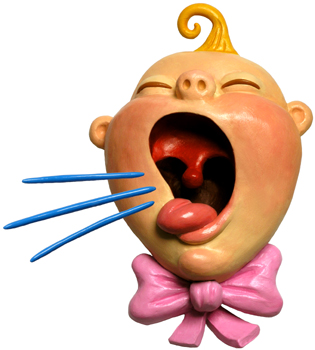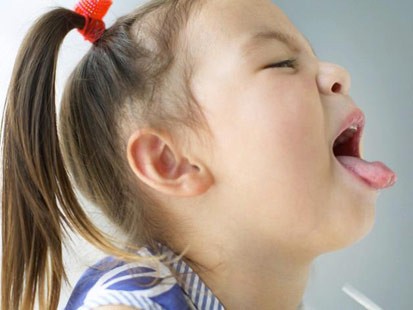 Whooping cough is a bacterial infection of the upper respiratory tract, primarily effecting
Whooping cough is a bacterial infection of the upper respiratory tract, primarily effecting

both vaccinated and unvaccinated children. It’s highly contagious, and adult whooping cough is not uncommon. It starts as a common cold and develops into a spasmodic, persistent, suffocative cough accompanied by a sore throat, fever, mucus secretion and vomiting. Coughing continues until the lungs are emptied of air and the sudden, hard intake of breath causes the characteristic whooping sound. Coughing attacks are fierce and can occur up to 40 times daily, lasting for two months or longer.
Causes
Whooping cough is caused by the bacterium Bordetella pertussis. The bacterium is transmitted in tiny droplets that come from the nose and mouth and is spread from person to person. While most cases of pertussis occur in children under 5 years, it may be that the majority of carriers are older. It’s now believed that adults are a major source of infection to infants. Since many people reach adulthood without having been infected, it’s entirely possible for adults to develop whooping cough. After infants, the people most likely to suffer serious complications from whooping cough are seniors and those with chronic ill health. The disease takes 1 or 2 weeks to incubate. People become infectious to others by the end of the first week and they typically remain contagious for about 6 weeks. The disease is highly contagious and you will be advised to avoid contact with others while you are still able to infect people.
Symptoms
The disease has 3 stages.
The first stage begins about 10 days after infection and causes symptoms like a -common cold
sneezing, 
watery eyes
tiredness, and
loss of appetite.
dry hacking cough.
The second stage occurs after 10 to 14 days and is signalled by a rapid increase in the frequency and severity of coughing. It’s this cough that gives the disease its name. Half a dozen or more rapid coughs follow each other in quick succession, followed by a “whooping” sound as the person inhales deep and fast. It may happen hundreds of times in a single day. The coughing may produce large amounts of thick mucus. Sometimes infants swallow it, but it may exit through the nostrils, often forming bubbles. Frequent coughing and mucus can cause vomiting, and choking is a risk in infants. Infants are actually less likely to  make the whooping sound than are older children, but they’re more likely to have a choking spell. Infected adults rarely whoop – they just cough frequently and spasmodically.
make the whooping sound than are older children, but they’re more likely to have a choking spell. Infected adults rarely whoop – they just cough frequently and spasmodically.
After a month, most people start to look and feel better and cough less. This is the third stage – a gradual recovery taking a few weeks or occasionally a few months. The usual total course of the disease lasts 6 to 10 weeks.
Complications of Pertussis
The most common complication associated with whooping cough is pneumonia. Although the bacteria can lead to ear infections, dehydration, convulsions, and, in rare instances, brain damage or death. Pertussis poses a greatest risk to infants and small children due to the small size of their air passages. For this reason, they are at the highest risk for pertussis and its complications compared to older children and adults.
Homoeopathy aspect of Prevention and Treatment Options
There are many homeopathic remedies which can be used in the treatment of whopping cough depending on the stage of the illness and the symptoms the child is expressing. With the correct remedy contracted whooping cough can be resolved relatively quickly, ie in 2-10 days, thereby reducing the level of suffering and length of suffering. While  antibiotics are used in conventional medicine to kill the bacteria. If the whoop has entered the spasmodic stage of the illness, in contract to the correct homeopathic remedy they will not change the course of the disease.
antibiotics are used in conventional medicine to kill the bacteria. If the whoop has entered the spasmodic stage of the illness, in contract to the correct homeopathic remedy they will not change the course of the disease.
Use of whooping cough nosode (Pertussin) in ascending potencies as outlined on the STATUS SHEET for a standard prevention protocol (See schedule below). Doses are to be given over a few month period starting with 200C, repeating a triple dose of the 200C the following week then a triple dose of 10M followed one month later with a second round of the 10M.Use of Drosera, preventatively or if the disease is contracted as this remedies correspond to the common symptom manifestations of Measles. They can be used if there is known exposure or at the first signs of the disease and correspond to fluctuating temperatures, or runny nose and watery eyes, respectively. These remedies can be alternated if you are unsure, repeating the remedy that offers the most relief.Various other remedies in active disease: Ipecacuanha, Coccus cacti, antim tart, arsenic alb etc are helpful.
Pertussin may be used as a prophylaxis remedy for whooping cough, and may in fact abort a case of recently contracted whooping cough.
The goal of Homoeopathy is to introduce into the human system the energetic components of particular diseases in order to stimulate the immune system. Homeopathic Nosodes, such as Pertussin, are potentized preparations of the disease germ or discharges produced in response to whooping cough. Upon repetition of the particular remedy it is
understood that some aspect of susceptibility to the particular disease has been fulfilled.




